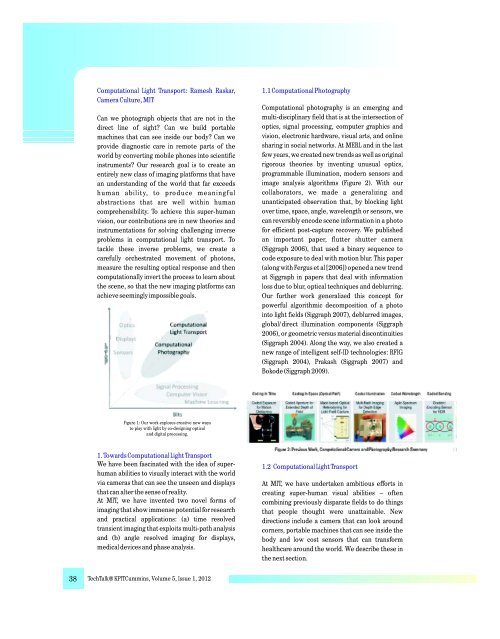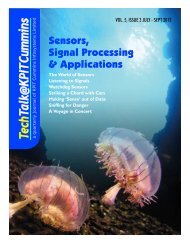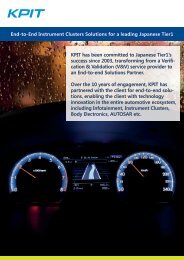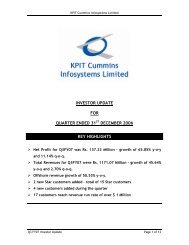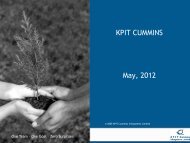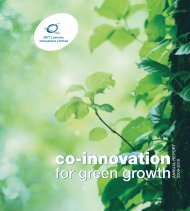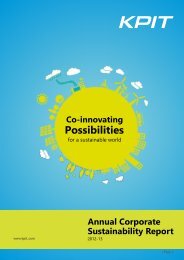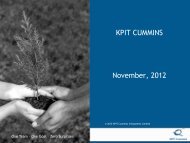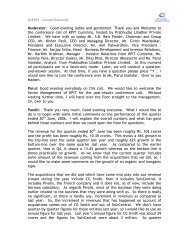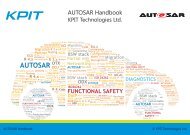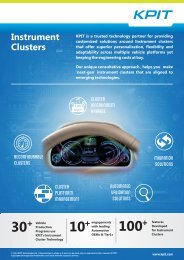INNOVATIONS FROM THE EDGE - KPIT
INNOVATIONS FROM THE EDGE - KPIT
INNOVATIONS FROM THE EDGE - KPIT
Create successful ePaper yourself
Turn your PDF publications into a flip-book with our unique Google optimized e-Paper software.
Computational Light Transport: Ramesh Raskar,<br />
Camera Culture, MIT<br />
Can we photograph objects that are not in the<br />
direct line of sight Can we build portable<br />
machines that can see inside our body Can we<br />
provide diagnostic care in remote parts of the<br />
world by converting mobile phones into scientific<br />
instruments Our research goal is to create an<br />
entirely new class of imaging platforms that have<br />
an understanding of the world that far exceeds<br />
human ability, to produce meaningful<br />
abstractions that are well within human<br />
comprehensibility. To achieve this super-human<br />
vision, our contributions are in new theories and<br />
instrumentations for solving challenging inverse<br />
problems in computational light transport. To<br />
tackle these inverse problems, we create a<br />
carefully orchestrated movement of photons,<br />
measure the resulting optical response and then<br />
computationally invert the process to learn about<br />
the scene, so that the new imaging platforms can<br />
achieve seemingly impossible goals.<br />
1.1 Computational Photography<br />
Computational photography is an emerging and<br />
multi-disciplinary field that is at the intersection of<br />
optics, signal processing, computer graphics and<br />
vision, electronic hardware, visual arts, and online<br />
sharing in social networks. At MERL and in the last<br />
few years, we created new trends as well as original<br />
rigorous theories by inventing unusual optics,<br />
programmable illumination, modern sensors and<br />
image analysis algorithms (Figure 2). With our<br />
collaborators, we made a generalizing and<br />
unanticipated observation that, by blocking light<br />
over time, space, angle, wavelength or sensors, we<br />
can reversibly encode scene information in a photo<br />
for efficient post-capture recovery. We published<br />
an important paper, flutter shutter camera<br />
(Siggraph 2006), that used a binary sequence to<br />
code exposure to deal with motion blur. This paper<br />
(along with Fergus et al [2006]) opened a new trend<br />
at Siggraph in papers that deal with information<br />
loss due to blur, optical techniques and deblurring.<br />
Our further work generalized this concept for<br />
powerful algorithmic decomposition of a photo<br />
into light fields (Siggraph 2007), deblurred images,<br />
global/direct illumination components (Siggraph<br />
2006), or geometric versus material discontinuities<br />
(Siggraph 2004). Along the way, we also created a<br />
new range of intelligent self-ID technologies: RFIG<br />
(Siggraph 2004), Prakash (Siggraph 2007) and<br />
Bokode (Siggraph 2009).<br />
Figure 1: Our work explores creative new ways<br />
to play with light by co-designing optical<br />
and digital processing.<br />
1. Towards Computational Light Transport<br />
We have been fascinated with the idea of superhuman<br />
abilities to visually interact with the world<br />
via cameras that can see the unseen and displays<br />
that can alter the sense of reality.<br />
At MIT, we have invented two novel forms of<br />
imaging that show immense potential for research<br />
and practical applications: (a) time resolved<br />
transient imaging that exploits multi-path analysis<br />
and (b) angle resolved imaging for displays,<br />
medical devices and phase analysis.<br />
1.2 Computational Light Transport<br />
At MIT, we have undertaken ambitious efforts in<br />
creating super-human visual abilities – often<br />
combining previously disparate fields to do things<br />
that people thought were unattainable. New<br />
directions include a camera that can look around<br />
corners, portable machines that can see inside the<br />
body and low cost sensors that can transform<br />
healthcare around the world. We describe these in<br />
the next section.<br />
38 TechTalk@<strong>KPIT</strong>Cummins, Volume 5, Issue 1, 2012


